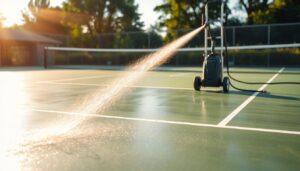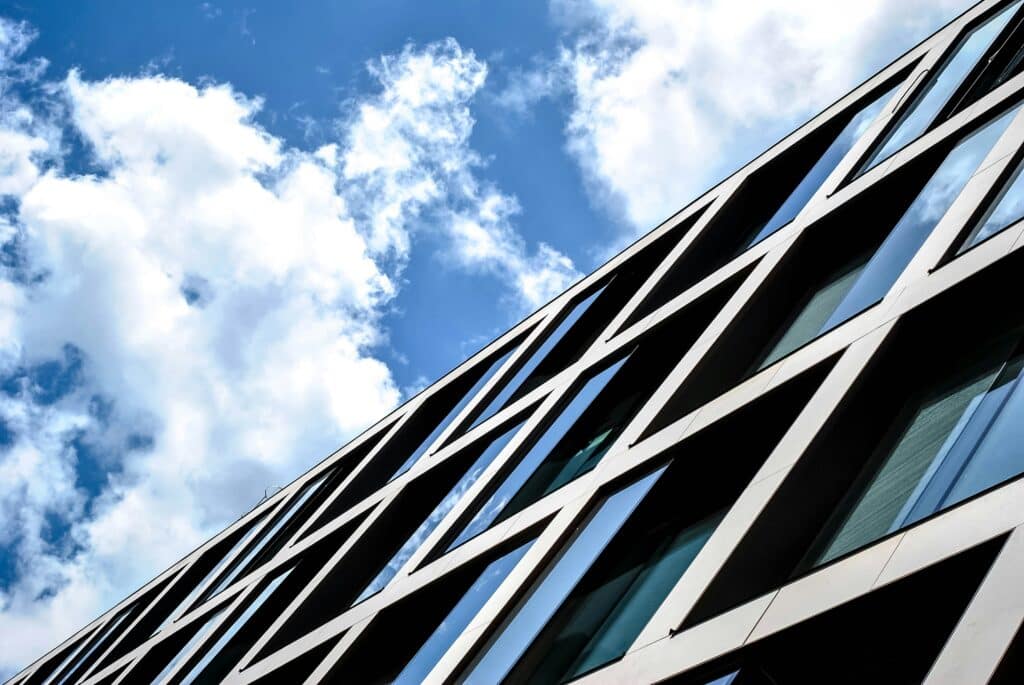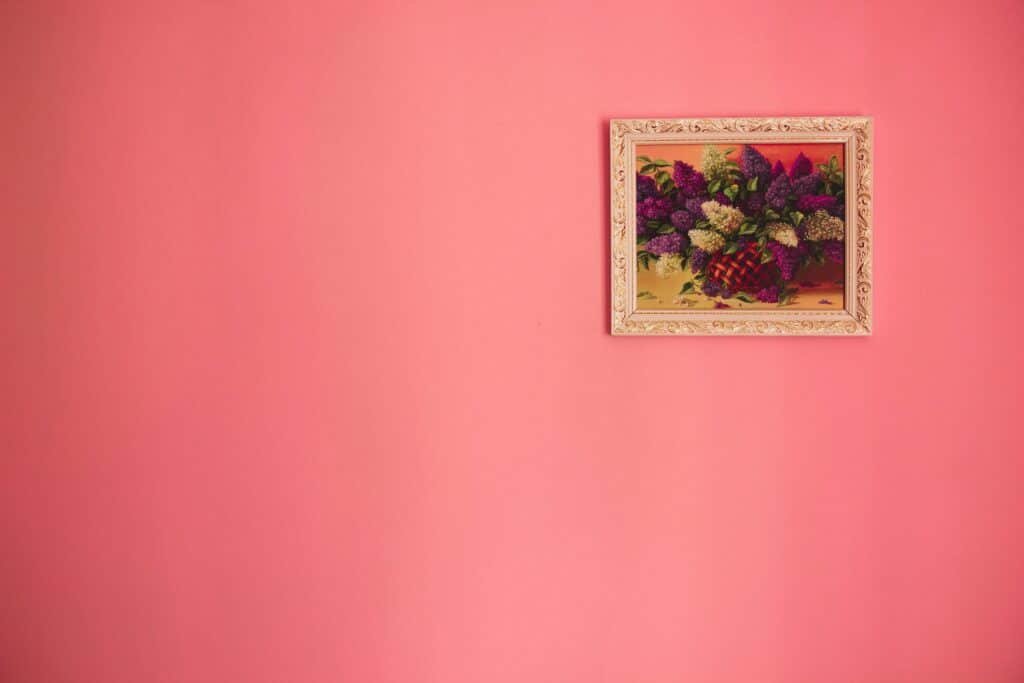Keeping a tennis court in top shape is key to its longevity and safety. In Australia, pressure cleaning is a must to get rid of dirt, debris, and mold. This helps protect the court surface. Good maintenance makes playing safer and keeps the court looking great for longer.
For a professional court, daily checks for wear and tear are a must. Look out for surface water and weeds. Without proper care, courts can be slippery, leading to injuries. Court lines may need repainting often due to wear and weather damage. Deep cleaning courts once a year is important. Regular upkeep can make them last longer and save on repair costs.
Keeping courts clean stops waste matter from causing damage. Hard surface courts should not be washed with high-pressure washers. Instead, use mild detergent and water. By adding pressure cleaning to your routine, you can avoid expensive fixes and ensure a safe play area.
Key Takeaways
- Regular tennis court maintenance is essential for extending the life of the court and ensuring player safety.
- Tennis court pressure cleaning is a crucial part of maintenance, as it helps to remove dirt and mold.
- Proper drainage is crucial for preventing water accumulation and reducing the risk of damage.
- Regular checks for wear and tear should occur daily, including inspections for surface water and weeds.
- A deep clean of outdoor tennis courts should be conducted about once a year to maintain a professional tennis court surface.
- Regular maintenance can increase the longevity of tennis courts and reduce repair costs.
- Effective pressure cleaning techniques and equipment are vital for maintaining a professional tennis court.
Understanding the Importance of Professional Tennis Court Pressure Cleaning
Cleaning and maintenance are key for tennis courts. They keep the court looking good, playing well, and lasting longer. Professional cleaning ensures surface quality, which is crucial for player safety.
A clean court also makes the facility more attractive. This can draw in more players and visitors.
Professional cleaning boosts the court’s lifespan and safety. Eco-friendly solutions remove stains safely for players and the environment. Proper washing can make the court last 20% longer.
- Reduced risk of slips and injuries, which account for approximately 30% of all sports-related injuries
- Extended lifespan of the court, which can be up to 20 years with proper care
- Improved player safety and confidence
- Cost benefits, including reduced repair costs and extended court lifespan
Regular checks and upkeep can save up to 30% on repair costs. A custom maintenance plan can also improve court performance and extend its life. This avoids expensive renovations.

Essential Equipment and Materials for Court Cleaning
Cleaning a tennis court needs the right tools and materials. You’ll need pressure washers, soft-bristle brushes, and mild detergents. High-quality cleaning stuff is key to avoid damage and get the court clean.
Regular cleaning can make your court last longer, saving you money on repairs. Professional cleaners can do the job in a few hours, depending on the court’s size and state. They use special equipment like commercial-grade pressure washers to clean well without harming the surface.
Some must-haves for cleaning tennis courts include:
- Pressure washers for deep cleaning
- Soft-bristle brushes for gentle scrubbing
- Mild detergents for effective cleaning without damage
- Tennis court surface protection products to prevent damage and extend lifespan
Using eco-friendly, court-safe cleaning solutions is also vital. This ensures the surface isn’t harmed and play remains safe. With the right gear and materials, court owners can keep their courts clean and safe. This improves the playing experience by enhancing traction and ball bounce.
Having proper drainage systems is essential to keep water away from the court. Regular upkeep, like sweeping and rinsing, helps stop dirt from building up. By investing in quality equipment and materials, court owners can keep their courts in great shape. This ensures a safe and fun playing experience for everyone.
Pre-Cleaning Assessment and Preparation
Before starting the tennis court cleaning, a detailed pre-cleaning assessment is key. It helps choose the right cleaning method based on the surface type. It also checks for mold or mildew and keeps an eye on nearby plants to avoid waste matter.
Understanding the surface type is crucial for the cleaning method. It prevents damage and keeps the court in good shape for longer. Weather also matters a lot in the assessment, as it can affect how well and safely the cleaning goes.
Safety is the top priority in tennis court cleaning prep. It’s important to protect both the cleaners and the court from harm. By focusing on safety, managers can make sure the cleaning is both safe and effective. Important safety steps include:
- Wearing protective gear, such as gloves and safety glasses
- Ensuring proper ventilation to prevent the accumulation of cleaning solution fumes
- Using eco-friendly cleaning products to minimize environmental impact
By focusing on pre-cleaning steps, managers can give their tennis courts the best care. This leads to better playing conditions and a longer-lasting facility. Regular checks and preparations are essential for a top-notch playing surface.
Professional Tennis Court Pressure Cleaning Techniques
Keeping tennis courts clean is key to their quality and life span. Regular cleaning stops stains and wear, making play safe and fun. It’s wise to clean the court every month, using a mix of 4 parts water to 1 part bleach.
Pressure washing is vital for cleaning tennis courts. It should be done gently to protect the colors. Eco-friendly cleaners are also good, as they’re kinder to the court and the planet. Always follow the cleaner’s instructions and wear safety gear.
Important tips for cleaning tennis courts include:
- Adjusting pressure to avoid harm to the court
- Applying cleaners right to stop stains and wear
- Checking drains to stop blockages
- Keeping plants around to ensure good drainage
By sticking to these cleaning methods and using the right pressure washing, courts stay in top shape. This gives players a great experience.

Addressing Common Court Contaminants
Tennis courts often face issues like moss, algae, and mould. These can harm the surface quality and safety. Keeping the court clean is key to a good playing experience.
There are many ways to clean tennis courts, like pressure washing and manual cleaning. But, picking the right method and solution is crucial to avoid damage.
- Moss and algae treatment using specialized cleaning solutions
- Mould prevention strategies, such as regular cleaning and drying
- Dealing with surface stains using targeted cleaning solutions
By tackling common contaminants, court owners can make their courts last longer. They can also save on maintenance and ensure players have a great time.
Seasonal Maintenance Requirements for Australian Courts
Australian tennis courts need regular care to stay safe and in top shape. The country’s weather changes a lot, so upkeep is key to avoid damage. This keeps the courts looking great for players.
It’s important to sweep and deep clean the courts often. How often depends on how much they’re used and the weather. Courts in wet or very hot areas need more attention.
- Regular checks to fix any damage to the surface
- Using protection to shield the court from harsh weather
- Cleaning the court’s edges and making sure the surface is even
By doing these tasks, Australian tennis courts stay in great shape. This ensures players have a safe and fun place to play. It’s also vital to tailor maintenance to the court’s surface type. This way, upkeep is as effective as possible.
Post-Cleaning Care and Surface Protection
After a thorough cleaning, it’s key to focus on post-cleaning care and surface protection. This helps keep the tennis court in good shape for longer. It’s important to dry the court well to avoid water spots and damage.
Make sure the court is dry before adding any protective coating. Having a maintenance schedule is also crucial. It keeps the court in top condition all year round.
Regular checks are essential to spot any issues early. This includes looking at the court’s drainage system. Water buildup can cause damage and expensive repairs. Adding a protective coating to the maintenance plan can make the court last longer.
To keep the court in great shape, follow a regular maintenance schedule. This includes:
- Regular cleaning to prevent dirt buildup
- Applying a protective coating to enhance the surface’s durability
- Inspecting the drainage system to prevent water accumulation
By taking these steps, the tennis court will stay safe, clean, and well-maintained. This ensures a high-quality playing surface for years to come.
Conclusion
Keeping a tennis court in top shape is a big job, but it’s worth it. Regular care can make the court last longer. This ensures a safe and enjoyable play area for years.
Professional tennis court pressure cleaning is key to keeping the court clean. It stops damage and keeps the court looking great. Adding seasonal upkeep, protective layers, and resurfacing helps keep the court in top condition in Australia.
Starting a tennis court might seem expensive at first. But, a well-kept tennis court is safer and lasts longer. Investing in maintenance is a wise choice for any court.
Get our expert’s advice and keep your court in perfect shape.
FAQ
Why is regular tennis court pressure cleaning essential?
Regular tennis court cleaning solutions ensure that the surface remains safe and playable, helping to maintain tennis court specifications. Pressure washing a tennis court removes dirt and grime, pine needles, and unsightly mould, which can affect the quality of play. A clean court inhibits moss growth and algae growth, preventing costly repairs. Proper cleaning services also promote positive water flow and protect the surface from damage caused by standing water or debris around the court.
What equipment and materials are needed for tennis court pressure cleaning?
To clean your tennis court properly, you need a pressure washer, a blower and broom, and a soft brush for delicate areas. A pressure cleaner with adjustable pressure of the water is crucial to avoid damaging the tennis surface. You’ll also need a basic mixture of water and mild cleaning agents to inhibit unsightly stains and the growth of mould. For synthetic grass tennis courts, specialised cleaning services are required to maintain low required maintenance. Using the right equipment ensures professional tennis court cleaning services deliver quality tennis court cleaning.
How do I prepare for tennis court pressure cleaning?
First, inspect your court for damage, low spots, and debris that may create a dam and prevent proper water drainage. Remove any waste matter, such as leaves, fertilizer residues, and pine needles, with a blower and broom before starting. Ensure positive water flow by clearing clogged drains, and rinse the surface with a solution of water to loosen dirt. Notice signs posted for safety, and if pressure cleaning services are hired, request a free quote for commercial pressure cleaning or additional resources if needed. Proper preparation helps protect the surface and ensure an effective cleaning process.
What are the professional techniques used for tennis court pressure cleaning?
Professional pressure cleaning specialists use a controlled pressure cleaner to wash the court without causing surface damage. High pressure is used for stubborn stains on asphalt courts, while a soft brush and low-pressure settings are used for synthetic grass tennis courts. Roof cleaning techniques can also be applied to remove unsightly stains caused by overhanging trees. Experts ensure the flow of water is directed properly to avoid creating a dam. Regular tennis court cleaning per the guidelines keeps the court and surrounding areas in optimal condition.
How do I deal with common contaminants on my tennis court?
Moss growth, algae growth, and unsightly mould can degrade the court surface. To inhibit these contaminants, use weed killers and eco-friendly tennis court washing solutions. A thorough wash is necessary to remove chemical residues that may affect the quality of play. Graffiti removal techniques can be applied to remove paint or markings from basketball court surfaces and pickleball courts. Regular maintenance and low spot removal help prevent water buildup that encourages the growth of mould.
What seasonal maintenance is required for Australian tennis courts?
Australia’s climate requires regular care and maintenance throughout the year. Rain and humidity promote the growth of mould and algae, requiring tennis court cleaning solutions to prevent slippery surfaces. Dry conditions may lead to dust buildup, affecting playability. Professional tennis court cleaning services can help keep your court well-maintained year-round. Washing the court thoroughly and ensuring proper drainage protects the surface from long-term damage. Regular inspections allow for early detection of surface wear and the need to have the court resurfaced if necessary.
How do I care for and protect the tennis court surface after cleaning?
After cleaning, thoroughly wash the surface to remove any remaining cleaning agents. Regular maintenance includes using a blower to remove debris, checking for low spots, and making sure water drains correctly. To maintain tennis court specifications, keep your court free from standing water that can lead to costly repairs. Rinse the court after each use, especially if fertilizer or other chemicals have been applied nearby. Professional pressure cleaning services can provide specialty treatments to protect the surface and keep it looking its best for years to come.




